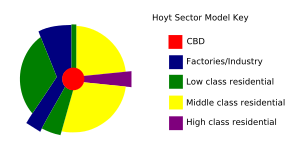Sector model facts for kids
The Sector model is a way to understand how cities grow and are organized. It was created by a person named Homer Hoyt in 1939. He studied many cities in the United States to see how they developed.
Hoyt's idea was different from earlier models that suggested cities grew in perfect circles, like rings on a tree. Instead, he found that cities often grow outwards in "wedges" or "sectors." Think of a city as a pie, and different types of areas (like homes, shops, or factories) grow in specific slices of that pie.
How Cities Grow in Sectors
Homer Hoyt noticed that certain parts of a city tend to expand outwards from the center along main roads, rivers, or railway lines. For example:
- High-income homes: Wealthy areas often grow along attractive routes, like a nice street or a riverbank, extending outwards from the city center.
- Industrial areas: Factories and businesses that need good transport might grow along railway lines or major roads, forming their own sector.
- Low-income homes: Poorer housing areas might also form sectors, often next to industrial zones or less desirable land.
This means that if you have a fancy neighborhood in one part of the city, it tends to stay in that "slice" as the city gets bigger, rather than spreading out in a circle around the whole city.
Why the Sector Model is Useful
The Sector model helps people who plan cities (called urban planners) understand how different parts of a city develop. It shows that land use isn't random; it often follows patterns based on transportation and where different groups of people or businesses want to be.
This model was an important step in understanding how cities change and grow over time. It showed that things like transport routes and the type of housing can strongly influence a city's shape.
Related pages


